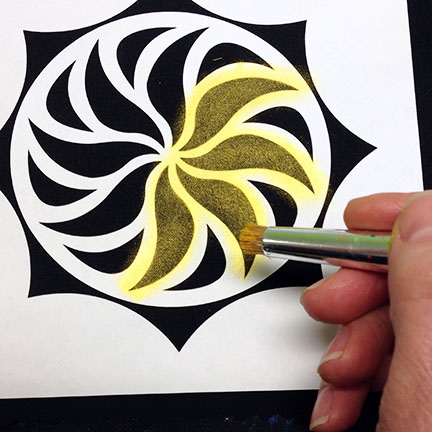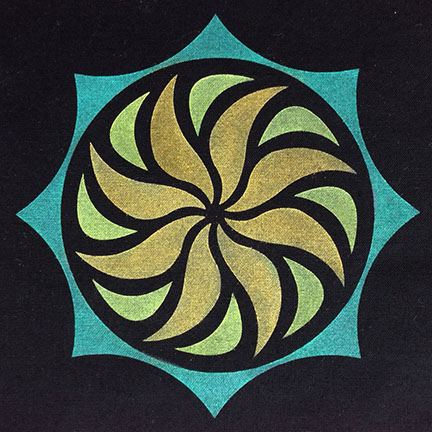Journal
Titanium Is A Stenciler’s Best Friend

In the past month, I have spent between 25 and 30 hours stenciling images on a new project. I am working on black fabric and a nice range of iridescent and matte Paintstik colors. For my project, I wanted my images bold and bright. Yes, I wanted them to jump off the fabric.
Now that I have had lots (read that LOTS) of practice, I can tell you a few things I have learned and forgotten several times over the years. This week we will talk about why every Paintstik toolbox should include a stick of Titanium White. Next week we will explore Extreme Stenciling.
Stenciling 101
If you are going to stencil images, we clearly have to start with a stencil. I am using a stencil I cut from label paper with my Silhouette Cameo cutter.
You can cut your own stencils by hand from freezer paper and adhere the paper to your fabric with a warm iron, or you can purchase pre-cut mylar stencils from many sources, including our Online Store.
To stencil images with paintstiks, you need Paintstiks, brushes and and something like a piece of freezer paper to act as a palette surface. Remove the film from the end of your paintstiks, rub a generous amount on your palette surface, and pick up the paint with a stencil brush.
The usual sequence I teach for stenciling is this: Put the paint on the palette surface, load the paint onto the brush, and apply the paint with a gentle, circular scrubbing motion. Continue to add layers of paint until you are happy with the image.
At this point, I have colored in all of the openings of the stencil with iridescent Light Gold, Lime and Jade Green Paintstik colors. Note that you can still see a lot of black coming through the paint. This is because iridescent colors are very translucent. It takes a lot of layers of paint to build up an opaque layer of these colors.
Here is the image after I peeled off the stencil. Very soft and subtle, but not exactly dynamic. How can we get a more opaque image? By turning to our new best friend, Titanium White.
Start With Titanium White
If you love working with dark colored fabric (or paper) and iridescent Paintstik colors, you really need a stick of Titanium White (a matte color) in your toolbox.
The Titanium pigment is incredibly opaque, and just a thin layer helps to block out the darkness of the fabric. Applying a layer of Titanium White to your fabric is just like using a coat of stain-killer on your walls. It does not completely hide the color underneath, but it makes it much easier to cover up with your paint.
Another little time-saver is to add some color directly to the stencil with the Paintstik, then smooth the paint out with a stencil brush.
Please note this is easy when using paper stencils (sticker paper, freezer paper, etc.), but not always a good idea for mylar stencils. Paper stencils are very thin and you have less chance of having a big build up of paint around the edges. Even the thinnest of mylar stencils are thick enough to create a challenge.
If you are new to stenciling with Paintstiks or need a refresher, go through these steps with both paper and plastic or mylar stencils. The difference may surprise you.
Here is the result before the stencils is removed.
Once the stencil is removed, you can see that the images is still soft, and not in-your-face bright. While there is more paint on this sample than the first one, the paint layer is thin enough that it won’t change the softness or drape of the fabric. This is what I call a nice middle-of-the-road result.
To make it easier to compare, I have put the two images side by side. As you can see, the addition of that thin layer of Titanium White made a big difference for just a tiny bit of additional work.
Resources
I used the following items as I created the samples for this blog post:
- Iridescent Paintstiks (Light Gold, Lime, Jade)
- Matte Paintstiks (Titanium White)
- Short-handled Paintstik Brushes
- Label Paper from Online Labels (I use their Large Format sheets)
How Do You Make Opaque Stenciled Images?
I know that many of you have been playing with Paintstik colors for a long time. Do you have a “secret weapon” or special technique for getting an opaque image? I would love to hear your suggestions — as well as your questions. Leave a comment below and I will get back to you shortly.











Question: Do you let the white dry before adding the other colors? I am assuming not…would that be because the layer would be too “hard” and not give a good effect to paint overe?
Thanks,Liza Anne
Great question! Most of the time, I am much too impatient to let the Titanium White dry before I add the next layer. I just paint right over the top. I have noticed, however, that the white will mix into my color just a bit, and that can alter the color a bit. If it’s really important that the white not mix into the color, add a thin layer of white, let it dry overnight, and then continue the next day. (And it has to be REALLY important for me to wait!)
hi,Shelly,Spring greetings from Canada!I love your paint stained hands, like mine{I cannot work with gloves}black base is the best for iridescent paint to do it`s purpose to glow in its enchantment.Did you know,that the iridescent butterfly collection in England to day look the same as the day they where pinned 100 years ago,their wings are covered with crystals that glow by bending the light,to eternity, love, Irena.
Thank you sooooo much for putting all the details on how to do a patterns and the colors….I am not where I can get lessons and this was so much help…..Norma
You are most welcome, Norma. Several of your friends in the Community have asked me to be really specific about the details when I do a post. I’m learning! By the way, the next post is a follow-on that you should really have fun with!
[…] we start, you may want to re-read last week’s post called Titanium Is a Stenciler’s Best Friend. I am going to start where we left off at the end of that post. Please keep in mind that I am using […]